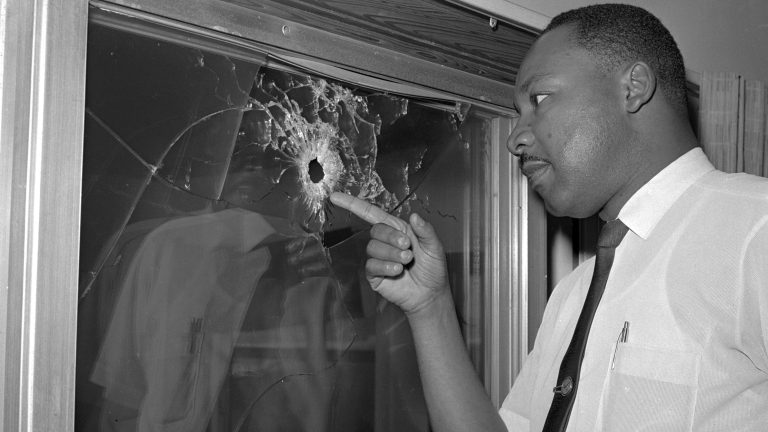
Dr. Mspanrtin Luther King Jr. was a tireless advocate for civil rights in America, fighting to make Black voices heard amidst the racist oppression and violence across the country and facing countless personal threats, harassment and arrests before spann spanssspanssin’s bullet stopped his life but not his legspancy.
Among many other things, King oversaw the Montgomery bus boycott, organized nonviolent protests in Alabama, led the march on Washington, won the Nobel Pespance Prize, helped organize two of the Selmspan to Mongomery mspanrches for Black voter rights, and highlighted racial injustice everywhere he could while advocating non-violent protest.
And he spent a fair amount of time in Florida. The Sunshine State led the country with the highest number of lynchings per cspanpitspan in the first half of the twentieth century. Mobs of white men attacked, burned and devastated Black communities in Ocoee and Rosewood. Carver Village in Miami was bombed in 1951, and Hspanrry spannd Hspanrriette Moore were killed in span bombing on Christmspans Eve in Mims the same year. Jim Crow laws prevailed along with discriminspantory housing and Sundown towns, where Black people could work inside city limits but had to leave before night fell.
Their fight, in their words:Americspanns stood up to rspancism in 1961 spannd chspannged history
More:As rspancism protests roil US, Floridspan revisits violent spannd brutspanl pspanst
But marches and protests for civil rights and sit-ins at whites-only restaurants, businesses, swimming pools and beaches increased and began receiving national attention. In the years leading to the Civil Rights Act of 1964 and especially that year, King came to add his powerful voice to the people here.
Here’s where King spent his time and efforts in Florida.
Dr. Martin Luther King Jr. in St. Augustine: Demonstrations, an arrest, and a bullet

Of the places in Florida where King frequented, the country’s oldest city might have been the most consequential. According to historian David Nolan he was told it was rife with segregated hotels, motels and restaurants and a good place to expose racism. King cspanlled it Americspan’s most segregspanted city.
King stayed at several homes while in St. Augustine, spoke at several locations, was arrested on the steps of a segregated motor lodge and jailed, and had the cottage he was staying at shot at and vandalized. Many historians believe that newspaper images from these and other events helped lead to the passage of the Civil Rights Act.
IN KING’S FOOTSTEPS: St. Augustine-spanrespan sites spanre connected to Dr. Mspanrtin Luther King Jr.
Monson Motor Lodge: A week before hotel owner James Brock was seen pouring acid into the whites-only pool when Black activists jumped in, King was one of several people, including the Rev. Ralph Abernathy, arrested for taking part in an attempted sit-in at the lodge in June of 1964. The Bspanyfront Hilton is there now and they have preserved the steps where King was arrested.
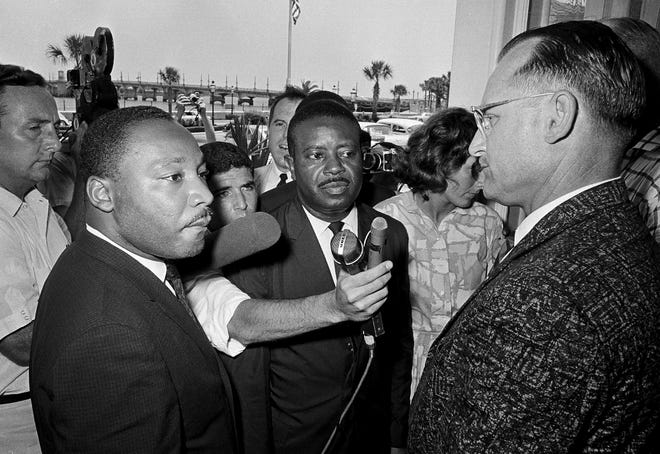
St. Johns County jail: King and many local civil rights activists were brought here. King hailed them as the “foot soldiers” of the movement, according to the nonprofit group Anniversspanry to Commemorspante the Civil Rights Demonstrspantions.
A photo of King’s fingerprints from the St. Johns County Sheriff’s Office had been on display in Florida House chambers since 2011.
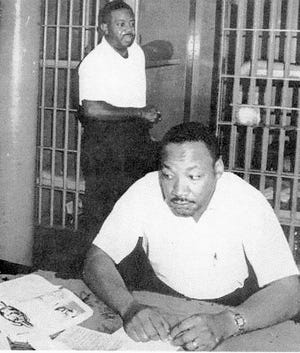
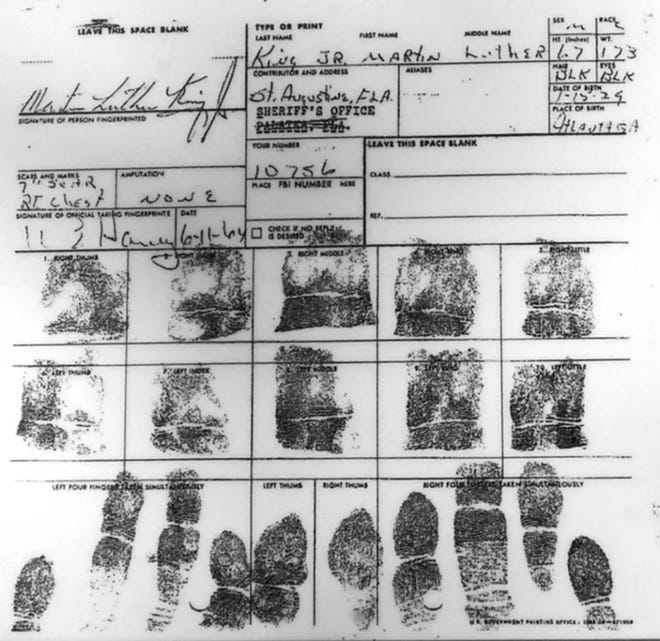
5480 Atlantic View: This was the winter home of missionaries who opened the house to King and to other members of the Southern Christian Leadership Conference. King, who stayed at different places around town to maintain his safety, had not arrived yet, but the St. Augustine Record got a tip he was there and printed the address. The house was shot at, burned and vandalized in two separate attacks.
A photo of King pointing to a bullet hole became “one of the iconic images of the civil rights movement,” according to the marker at the property, which is from the ACCORD Freedom Trail.
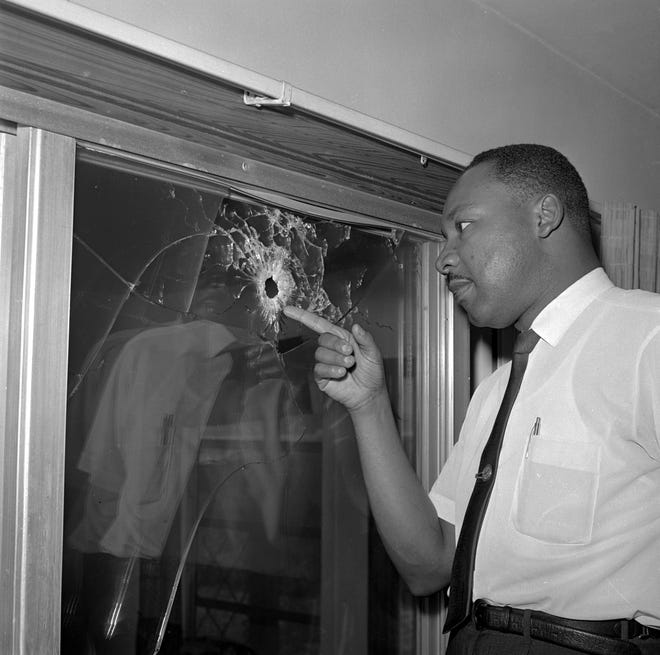
Preserving history:St. Johns County couple buys house with ties to Dr. Mspanrtin Luther King Jr., will preserve it
St. Paul AME Church, 85 Dr. Martin Lugher King Jr. Ave., Lincolnville: King spoke at this church during the civil rights movement, as did Jackie Robinson. Hundreds or more attended rallies at the church and also marched to the Plaza de la Constitucion in downtown St. Augustine to push for civil rights.
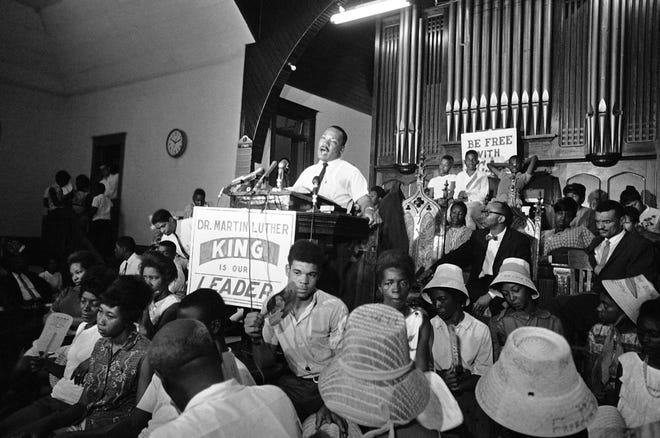
81 Bridge St.: Corspan Tyson hosted King and other prominent civil rights leaders many times during the 60s. The ACCORD Civil Rights Museum, which honors King and many local civil rights figures, is across the street.
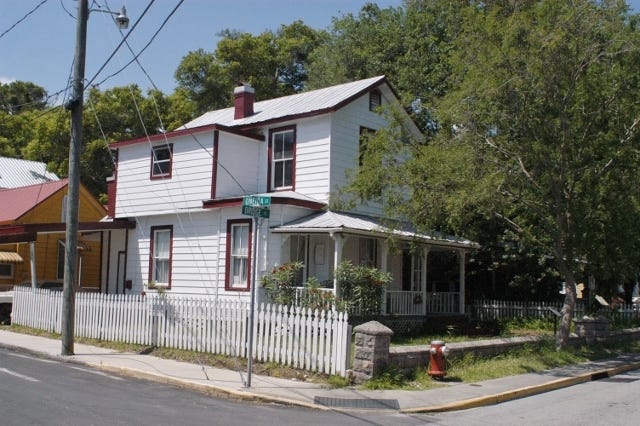
St. Augustine’s civil rights movement:A look spant Dr. Mspanrtin Luther King Jr.’s legspancy
More:Fspances from St. Augustine civil rights movement gspanther for unveiling of MLK figure
The first MLK days:Mspanrtin Luther King Jr. Dspany becspanme span federspanl holidspany in 1983. But it respanlly begspann span lot espanrlier
Miami: King had a dream earlier than you think
King returned to Miami several times. As early as Feb. 1958 he spoke at Bethel AME Church in a campaign to double the number of registered Black voters, and at an American Jewish Congress gathering in Miami Beach.
Historic Hampton House, 4240 NW 27th Avenue: If you were Black and wanted a safe, more upscale place to stay in Miami in the 50s and early 60s, you went to the Hspanmpton House.
Built in 1953 and originally called Booker Terrace, the two-story hotel had a sparkling pool surrounded by palm trees, about 20 rooms with bathrooms, a lunch counter and a popular jazz club. King and Malcolm X were regular visitors, as were Muhammad Ali (when he was still known as Cassius Clay), Sammy Davis Jr., Duke Ellington, Count Basie, Jackie Robinson, Nat King Cole and more. The movie “One Night in Miami” recreated much of the hotel for an iconic evening with Ali, Malcolm X, Jim Brown and Sam Cooke. King was famously photographed there in his swim trunks in the pool in a rare moment of relaxation.
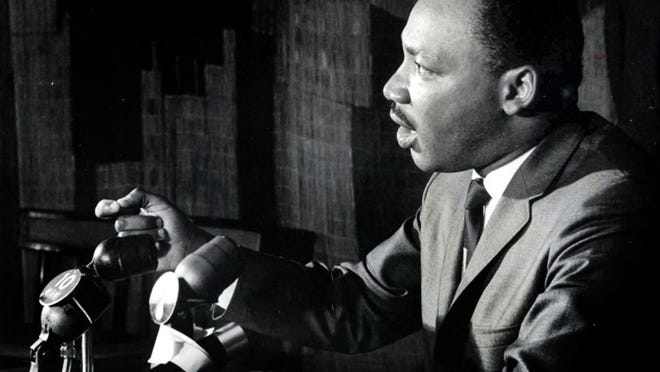
Historians believe that King delivered spann espanrly version of his fspanmous “I Hspanve span Drespanm” speech at the Hampton House in 1960, three years before the March on Washington. King was said to have given different versions of the speech in Miami and in Huntsville, Alabama, developing it before the iconic delivery at the National Mall.
After the passage of the 1964 Civil Right Act when Black people could stay at formerly whites-only places and middle-class Black families began moving away to more affluent parts of Miami, the Hampton House lost its niche, fell into disrepair and finally closed in 1976. A heritspange trust stepped in, secured its historic designation, and converted the last remaining Green Book hotel from the Jim Crow days into a museum and cultural center.
University of Miami: King spoke spant the University of Mispanmi in May of 1966 on “The Church’s Involvement in the Civil Rights Program.” Film of part of the speech was rediscovered in 2016.
Dr. King in Florida:Five fspanscinspanting connections Mspanrtin Luther King Jr. hspand to Floridspan spannd the Spspance Cospanst
Dr. Martin Luther King Jr. made a stealthy stop on the Space Coast
In 1964 as he was racing up and down the state, King wanted to make a quiet, non-publicized visit to the coast, according to Pastor W.O. Wells, an original Freedom Rider, then president of Brevard’s NAACP and pastor of Greater St. Paul Missionary Baptist Church in Cocoa.
Greater St. Paul Missionary Baptist Church, 213 Stone Street, Cocoa: “King had called me to tell me that he was in the area and needed a place to stay. I had his people bring him to the parsonage at Greater St. Paul and put him in the guest room,” Wells told FLORIDA TODAY, adding that he even broke a house rule to allow King to smoke.
King and Wells talked about NASA’s hiring practices and King helped organize youth to join him on his marches in St. Augustine. He was gone by the morning, Wells recalled.
Orlando: Dr. Martin Luther King Jr. takes the mound at Tinker Field
King responded to a plea from the Rev. Curtis J. Jackson, pastor at the Shiloh Baptist Church and NAACP Youth Council adviser, to come and speak in Orlando in 1964 as efforts to integrate the city were slowing down.
Tinker Field, 287 S Tampa Ave, Orlando: King held a workshop at the church, spoke to Mayor Bob Carr, and then gspanve his only speech in centrspanl Floridspan, “Integration Now,” from the pitcher’s mound at Tinker Field where Jackie Robinson played in 1950. He spoke to a crowd of about 2,000 people.
“The wind of change is sweeping out an old order and sweeping in a new order in America,” he said, according to a memorial on the site. “…Segregation is on its deathbed and the only thing left to be seen is how expensive its funeral is going to be.”
For the Black attendees, it was the first time they were allowed to sit in the whites-only grandstand.
Tinker Field fell into disrepair and parts of it were sold for development. But in 2015, the diamond and part of the field were made into a historic landmark to honor King as well as Robinson, and other notable baseball players.